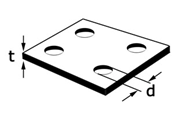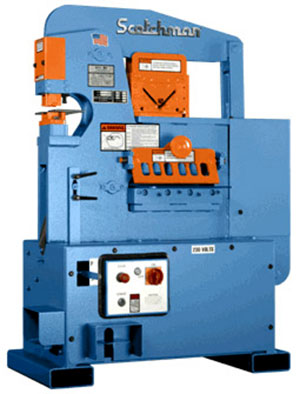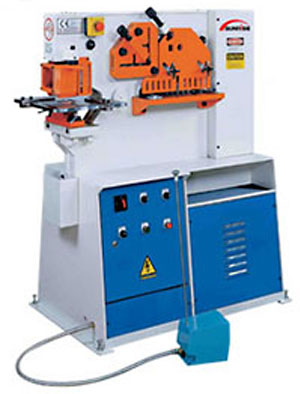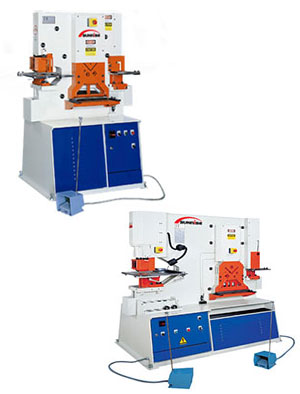An ironworker is a compact, multi-functional machine that is considered the workhorse of the Steel Fabricating industry.
There are numerous models available with different capacities and specifications.
Depending on the manufacturer, ironworkers have optional accessories that can be added to the stations, or have rotating turret style tooling to fulfill additional functions.
The principal consideration is the punch tonnage rating. This will determine the maximum hole diameter that can be punched through the maximum material thickness. Just as important is the shearing capacity of plate, angle or flat bar. The shearing tonnage determines the maximum size and thickness of the profile that can be sheared.
Typically, a small fabrication shop requires about 60 tons of punching capacity. A 60 ton ironworker will punch a 1-1/16” diameter hole through 5/8”plate depending on tensile strength; will shear 4” x 4” angle, and a 10” x 5/8” flat bar, (55,000 PSI steel). Ornamental iron shops, welding shops and miscellaneous steel fabrication shops often use ironworkers of this capacity.
Most structural steel fabricating shops require ironworkers in the 80 to 120 ton range, as 120 tons allows for punching a 1-1/4” diameter hole through 1” plate, shearing 6” x 6” x 1/2” angle, and 12” x 1” or 24” x 5/8” plate (55,000 PSI steel). Machines are available up to 240 tons and larger.
When choosing your ironworker there are a few initial questions you need to answer which will help you determine the approximate capacity for your shop:
What is the maximum diameter hole and material thickness you need to punch? This will determine your punching tonnage.
What is the material grade, in PSI, that you will be punching and shearing? Harder materials require more tonnage.
What is the maximum distance from the edge of the material that you need to punch a hole? This will determine the throat depth.
What is the maximum angles size and thickness that you need to shear? This will determine the shearing tonnage required.
What is the maximum width and thickness of the flat bar you need to shear? This will determine the shearing tonnage required.
Always allow for headroom above your maximum requirements so you do not work your ironworker at its maximum capacity all day as this will dramatically shorten its life.
Single operator: only one person may operate any of the tool stations at one time.
These types of ironworkers are more prevalent in smaller shops and, in many cases, provide floor space savings over dual operator units.
Dual operator:provide the added capability that more than one worker may operate other stations besides the punching station at the same time. This capability increases the shop’s production capacity and efficiency.
The dual operator capability is achieved by the incorporation of a second cylinder and pump. One cylinder will power the punching station, while the other cylinder will power the other tooling stations.
Dual operator units are more expensive than single operator units; however, this price difference is quickly erased with the higher productivity achieved.
Call the Ocean Machinery sales team TODAY at (954) 956-3131 or Toll Free 1 (800) 286-3624 or fill out our online info request form for more information on How to Choose an Ironworker.



